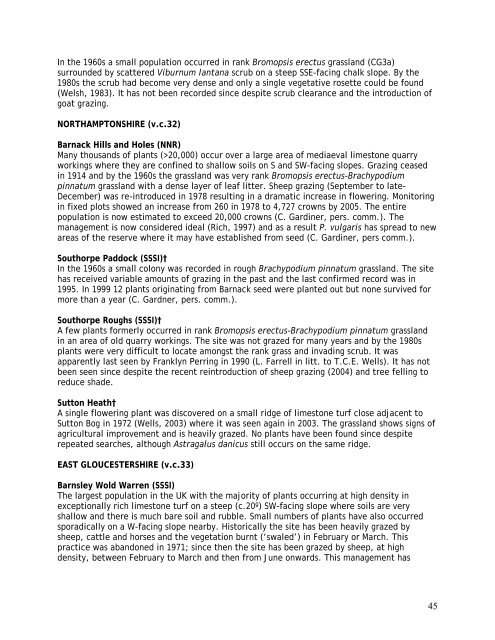Pulsatilla vulgaris (L.) Mill. - Plantlife
Pulsatilla vulgaris (L.) Mill. - Plantlife
Pulsatilla vulgaris (L.) Mill. - Plantlife
Create successful ePaper yourself
Turn your PDF publications into a flip-book with our unique Google optimized e-Paper software.
In the 1960s a small population occurred in rank Bromopsis erectus grassland (CG3a)<br />
surrounded by scattered Viburnum lantana scrub on a steep SSE-facing chalk slope. By the<br />
1980s the scrub had become very dense and only a single vegetative rosette could be found<br />
(Welsh, 1983). It has not been recorded since despite scrub clearance and the introduction of<br />
goat grazing.<br />
NORTHAMPTONSHIRE (v.c.32)<br />
Barnack Hills and Holes (NNR)<br />
Many thousands of plants (>20,000) occur over a large area of mediaeval limestone quarry<br />
workings where they are confined to shallow soils on S and SW-facing slopes. Grazing ceased<br />
in 1914 and by the 1960s the grassland was very rank Bromopsis erectus-Brachypodium<br />
pinnatum grassland with a dense layer of leaf litter. Sheep grazing (September to late-<br />
December) was re-introduced in 1978 resulting in a dramatic increase in flowering. Monitoring<br />
in fixed plots showed an increase from 260 in 1978 to 4,727 crowns by 2005. The entire<br />
population is now estimated to exceed 20,000 crowns (C. Gardiner, pers. comm.). The<br />
management is now considered ideal (Rich, 1997) and as a result P. <strong>vulgaris</strong> has spread to new<br />
areas of the reserve where it may have established from seed (C. Gardiner, pers comm.).<br />
Southorpe Paddock (SSSI)†<br />
In the 1960s a small colony was recorded in rough Brachypodium pinnatum grassland. The site<br />
has received variable amounts of grazing in the past and the last confirmed record was in<br />
1995. In 1999 12 plants originating from Barnack seed were planted out but none survived for<br />
more than a year (C. Gardner, pers. comm.).<br />
Southorpe Roughs (SSSI)†<br />
A few plants formerly occurred in rank Bromopsis erectus-Brachypodium pinnatum grassland<br />
in an area of old quarry workings. The site was not grazed for many years and by the 1980s<br />
plants were very difficult to locate amongst the rank grass and invading scrub. It was<br />
apparently last seen by Franklyn Perring in 1990 (L. Farrell in litt. to T.C.E. Wells). It has not<br />
been seen since despite the recent reintroduction of sheep grazing (2004) and tree felling to<br />
reduce shade.<br />
Sutton Heath†<br />
A single flowering plant was discovered on a small ridge of limestone turf close adjacent to<br />
Sutton Bog in 1972 (Wells, 2003) where it was seen again in 2003. The grassland shows signs of<br />
agricultural improvement and is heavily grazed. No plants have been found since despite<br />
repeated searches, although Astragalus danicus still occurs on the same ridge.<br />
EAST GLOUCESTERSHIRE (v.c.33)<br />
Barnsley Wold Warren (SSSI)<br />
The largest population in the UK with the majority of plants occurring at high density in<br />
exceptionally rich limestone turf on a steep (c.20º) SW-facing slope where soils are very<br />
shallow and there is much bare soil and rubble. Small numbers of plants have also occurred<br />
sporadically on a W-facing slope nearby. Historically the site has been heavily grazed by<br />
sheep, cattle and horses and the vegetation burnt (‘swaled’) in February or March. This<br />
practice was abandoned in 1971; since then the site has been grazed by sheep, at high<br />
density, between February to March and then from June onwards. This management has<br />
45

















